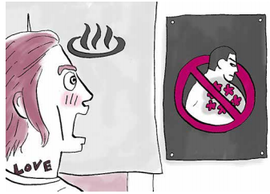“People with Irezumi or Tattoos Are Refused Entry to Bathhouses”
「入れ墨・タトゥーの方の入浴施設への入場はお断りします」
「入れ墨・タトゥーの方の入浴施設への入場はお断りします」
The number (1 of ) foreign visitors to Japan in 2015 was the highest ever, at approximately 20 million.
2015年の訪日外国人は約2,000万人で過去最高となりました。
(2 Besides) Japanese food and shopping, one of the most popular attractions for tourists are onsen (hot spring baths).
観光客の目当ての一つは、和食、買物と並んで温泉です。
However, in the entrances to many Japanese onsen there are signs that read, “People (3 with ) irezumi or tattoos are not allowed to take a bath.”
しかし日本の多くの入浴施設の入口には、入れ墨やタトゥーを入れた人の入浴禁止の立て札があります。
(4 In ) Japan, people associate irezumi (traditional Japanese tattoos) with gangsters, and are even apt to view those who have tattoos (5 for ) fashion reasons as being antisocial.
日本では入れ墨は暴力団員が入れているイメージがあり、ファッションで入れた人も反社会的と見られがちです。
In 2010 a defendant, who had entered a facility ignoring a “tattoos prohibited” sign, was sentenced (6 to ) seven months’ imprisonment.
2010年には「入れ墨お断り」の看板を無視して施設に入った被告に懲役7カ月の刑が言い渡されました。
In addition, back in 2002 during NHK’s “Kouhaku Utagassen,” there was quite a ruckus when singer Namie Amuro – who was then (7 at ) the height of her popularity – sang in a sleeveless dress that exposed the tattoos (8 on ) her arms.
さらに、それにさかのぼること2002年のNHK紅白歌合戦では、当時人気絶頂で腕にタトゥーを入れた安室奈美恵がノースリーブで歌い大きな騒ぎとなりました。
After a flood of protests (9 from ) viewers, starting from the following year, artists were banned from displaying tattoos.
視聴者から抗議が殺到し、翌年からは出演者のタトゥーの露出が禁止されました。
(10 On ) the other hand, Japanese people have become more familiar with tattoos (11 through) period TV dramas such as “Toyama no Kinsan.”
その一方で、「遠山の金さん」などのテレビ時代劇で入れ墨は日本人になじみのあるものです。
Kinsan masquerades as a friendly tattooed local, but is (12 in ) fact a magistrate there to unmask villains.
金さんは入れ墨をした気のよい町人を装っていますが、実は悪の正体をあばく奉行です。
In recent years, tattoos are popular (13 among ) the young as a fashion statement, and stickers that resemble real tattoos are also (14 on ) sale.
近年はファッションとしてタトゥーが若者の間で広がりつつあり、タトゥーを入れているように見えるシールも販売されています。
Generally, in Japan irezumi refers to tattooed images that have a deep cultural significance, while tattoos are done (15 in ) the Western-style.
一般的に日本では、入れ墨は文化に深く根づいたものを、タトゥーは西洋風なものを指します。
(16 In ) the run-up to the hosting of the Tokyo Olympics and Paralympics, more and more facilities are reassessing their attitudes towards irezumi and tattoos.
東京オリンピック・パラリンピック開催を見すえて、入れ墨やタトゥーを見直す施設が増えつつあります。
According to a survey carried out (17 by ) the Japan Tourism Agency in June, 2015, 56% of facilities replied that they “would not allow tattoos,” 31% “would allow tattoos,” and 13% “would allow them (18 with ) conditions,” like hiding them with a plaster.
観光庁が2015年6月に実施した調査では、タトゥーを断る施設は56%、受け入れは31%、シールで隠すなどの条件付きでの受け入れは13%でした。
2015年の訪日外国人は約2,000万人で過去最高となりました。
(2 Besides) Japanese food and shopping, one of the most popular attractions for tourists are onsen (hot spring baths).
観光客の目当ての一つは、和食、買物と並んで温泉です。
However, in the entrances to many Japanese onsen there are signs that read, “People (3 with ) irezumi or tattoos are not allowed to take a bath.”
しかし日本の多くの入浴施設の入口には、入れ墨やタトゥーを入れた人の入浴禁止の立て札があります。
(4 In ) Japan, people associate irezumi (traditional Japanese tattoos) with gangsters, and are even apt to view those who have tattoos (5 for ) fashion reasons as being antisocial.
日本では入れ墨は暴力団員が入れているイメージがあり、ファッションで入れた人も反社会的と見られがちです。
In 2010 a defendant, who had entered a facility ignoring a “tattoos prohibited” sign, was sentenced (6 to ) seven months’ imprisonment.
2010年には「入れ墨お断り」の看板を無視して施設に入った被告に懲役7カ月の刑が言い渡されました。
In addition, back in 2002 during NHK’s “Kouhaku Utagassen,” there was quite a ruckus when singer Namie Amuro – who was then (7 at ) the height of her popularity – sang in a sleeveless dress that exposed the tattoos (8 on ) her arms.
さらに、それにさかのぼること2002年のNHK紅白歌合戦では、当時人気絶頂で腕にタトゥーを入れた安室奈美恵がノースリーブで歌い大きな騒ぎとなりました。
After a flood of protests (9 from ) viewers, starting from the following year, artists were banned from displaying tattoos.
視聴者から抗議が殺到し、翌年からは出演者のタトゥーの露出が禁止されました。
(10 On ) the other hand, Japanese people have become more familiar with tattoos (11 through) period TV dramas such as “Toyama no Kinsan.”
その一方で、「遠山の金さん」などのテレビ時代劇で入れ墨は日本人になじみのあるものです。
Kinsan masquerades as a friendly tattooed local, but is (12 in ) fact a magistrate there to unmask villains.
金さんは入れ墨をした気のよい町人を装っていますが、実は悪の正体をあばく奉行です。
In recent years, tattoos are popular (13 among ) the young as a fashion statement, and stickers that resemble real tattoos are also (14 on ) sale.
近年はファッションとしてタトゥーが若者の間で広がりつつあり、タトゥーを入れているように見えるシールも販売されています。
Generally, in Japan irezumi refers to tattooed images that have a deep cultural significance, while tattoos are done (15 in ) the Western-style.
一般的に日本では、入れ墨は文化に深く根づいたものを、タトゥーは西洋風なものを指します。
(16 In ) the run-up to the hosting of the Tokyo Olympics and Paralympics, more and more facilities are reassessing their attitudes towards irezumi and tattoos.
東京オリンピック・パラリンピック開催を見すえて、入れ墨やタトゥーを見直す施設が増えつつあります。
According to a survey carried out (17 by ) the Japan Tourism Agency in June, 2015, 56% of facilities replied that they “would not allow tattoos,” 31% “would allow tattoos,” and 13% “would allow them (18 with ) conditions,” like hiding them with a plaster.
観光庁が2015年6月に実施した調査では、タトゥーを断る施設は56%、受け入れは31%、シールで隠すなどの条件付きでの受け入れは13%でした。


 RSS Feed
RSS Feed